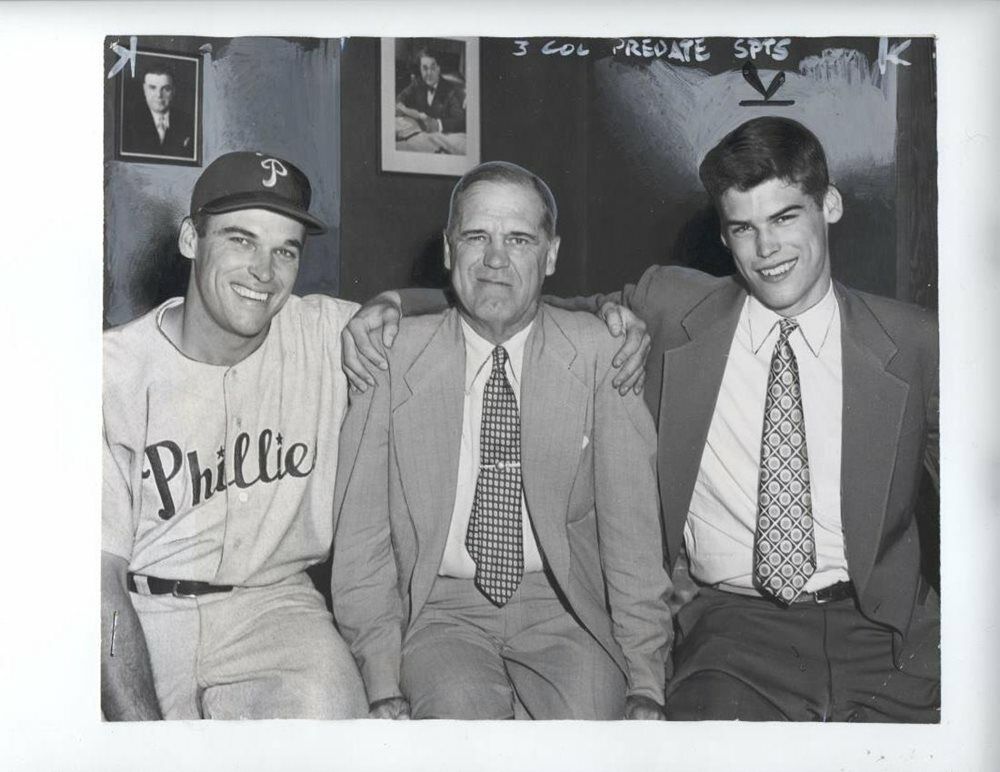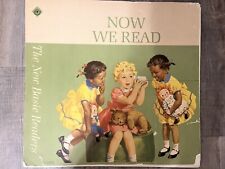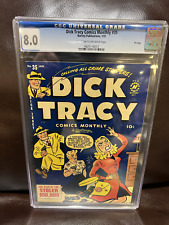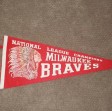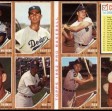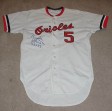When you click on links to various merchants on this site and make a purchase, this can result in this site earning a commission. Affiliate programs and affiliations include, but are not limited to, the eBay Partner Network.
A vintage original approximately 7 1/2 x 9 1/8 inch photo of Dick Sisler , George Sisler and Dave Sisler from 1951 with original paper on backRichard Alan Sisler (November 2, 1920 – November 20, 1998) was an American professional baseball player, coach, and manager in Major League Baseball (MLB). He was the son of Hall of Fame first baseman and two-time .400 hitter George Sisler. Younger brother Dave Sisler was a relief pitcher in the 1950s and 1960s with four MLB teams, and older brother George Jr. was a longtime executive in Minor League Baseball (MiLB).Contents1 Playing career1.1 Pennant-winning home run2 Coaching and managerial career3 See also4 References5 Further reading6 External linksPlaying career
Sisler\'s 1951 Bowman baseball cardSisler attended Colgate University. Listed at 6 feet 2 inches (1.88 m) tall and 205 pounds (93 kg), he batted left-handed and threw right-handed.
He was a journeyman left fielder and first baseman for the St. Louis Cardinals (1946–47; 1952–53), Philadelphia Phillies (1948–51) and Cincinnati Reds (1952). In an eight-season career, he hit .276 with 720 hits, 55 home runs and 360 RBI in 799 games.
Only with the Phillies did Sisler play on a consistent basis; he was Philadelphia\'s most-used first baseman in 1948 and 1949, and regular left fielder in 1950 and 1951. He made the National League All-Star team in 1950, a season during which Sisler reached personal bests in games played (141), games started (136, all in left field), at bats (523), runs scored (79), hits (155), doubles (29), homers (13), runs batted in (83), on-base percentage (.373), slugging percentage (.442) and batting average (.296). The season also gave Sisler lasting fame.
Pennant-winning home runOn the 1950 season\'s closing day, at Ebbets Field, with the game tied at one, Sisler hit a tenth-inning, opposite-field three-run home run against the Brooklyn Dodgers that led to the \"Whiz Kids\" Phillies winning the club\'s first National League pennant in 35 years. Had Philadelphia lost, the Phillies and Dodgers would have finished in a flatfooted tie for the NL championship and a best-of-three playoff would have resulted.
The home run made Sisler world-famous in both baseball and literary circles; Ernest Hemingway immortalized him in his novel The Old Man and the Sea. In a conversation between an aging Cuban fisherman and his young apprentice discussing the unfolding 1950 big-league season, the older man says:
\"In the other league, between Brooklyn and Philadelphia, I must take Brooklyn. But then I think of Dick Sisler and those great drives in the old park. There was nothing ever like them. He hits the longest ball I have ever seen.\"[1]
His father, George Sr., was a scout for Brooklyn in 1950. When asked after the pennant-winning game how he felt when his son beat his current team, the Dodgers, George replied, \"I felt awful and terrific at the same time.\"[2]
In the 1950 World Series that followed, however, Sisler would collect only one single in 17 at bats (.059), as the Phillies were swept by the New York Yankees in four games. Earlier, in 1946, he had gone hitless in two at bats as a pinch hitter for the Cardinals in that season\'s Fall Classic, but picked up a World Series ring when the Redbirds defeated the Boston Red Sox in seven games. Twenty-one years later, while serving as the Cardinals\' first base coach, he earned his second ring when St. Louis again defeated the Red Sox in a seven-game series.
Coaching and managerial careerAfter managing in the minor leagues with the Double-A Nashville Vols and Triple-A Seattle Rainiers, Sisler became a coach for Cincinnati in 1961, serving under manager Fred Hutchinson.
In August 1964, he was promoted to acting manager when Hutchinson, suffering from terminal cancer, was forced to give up the reins. He led the Reds to a 32–21 record, and the team finished in a second-place tie (with the Phillies), one game behind the Cardinals. After his formal appointment as manager in October 1964, he brought the Reds home fourth in 1965 with an 89–73 mark before being fired at season\'s end.[3] He then returned to the major league coaching ranks with the Cardinals (1966–70), San Diego Padres (1975–76) and New York Mets (1979–80). In his late sixties, he was still working with young players as a roving hitting instructor in the Cardinal farm system.
He died November 20, 1998, at the age of 78 in Nashville, Tennessee.[4]George Harold Sisler (March 24, 1893 – March 26, 1973), nicknamed \"Gentleman George\" and \"Gorgeous George\", was an American professional baseball player for 15 seasons, primarily as first baseman with the St. Louis Browns. From 1920 until 2004, Sisler held the Major League Baseball (MLB) record for most hits in a single season with 257.
Sisler\'s 1922 season — during which he batted .420, hit safely in 41 consecutive games, led the American League in hits (246), stolen bases (51), triples (18), and was probably the best fielding first baseman in the game — is considered by many historians to be among the best individual all-around single-season performances in baseball history.[1]
After Sisler retired as a player he worked as a major league scout and aide. He was on a team of scouts appointed by Branch Rickey to find black players for the Brooklyn Dodgers; the team\'s work resulted in the signing of Jackie Robinson.
Sisler was elected to the Baseball Hall of Fame in 1939.[2] In 1999 editors at The Sporting News named him 33rd on their list of \"Baseball\'s 100 Greatest Players\".Contents1 Early life2 Major league career3 Career statistics4 Later life and legacy5 See also6 Notes7 References8 Further reading9 External linksEarly lifeSisler was born in the unincorporated hamlet of Manchester (now part of the city of New Franklin, a suburb of Akron, Ohio[3]). His paternal ancestors were immigrants from Northern Germany in the middle of the 19th century. When he was 14, Sisler moved to Akron to live with his older brother so that he could attend an accredited high school. When Sisler was a high school senior his brother died of tuberculosis, but Sisler was able to move in with a local family and finish school.[4]
In 1911, Sisler signed a contract with the Pittsburgh Pirates to play minor league baseball in the Ohio–Pennsylvania League, but he never played in the league or earned any money[5] and instead played college ball for the University of Michigan. As a freshman pitcher, Sisler struck out 20 batters in seven innings during a 1912 game.[6] He lettered in baseball from 1913 to 1915.[7] At Michigan he played for coach Branch Rickey while earning a degree in mechanical engineering.[5]
After he graduated from Michigan, Sisler sought legal advice from Rickey about the status of his contract with Pittsburgh. The three-time Vanity Fair All-American had become highly sought-after by major league scouts. Rickey talked to Pittsburgh owner Barney Dreyfuss about releasing Sisler from the contract he had signed as a minor, but Dreyfuss maintained his claim to Sisler. Rickey wrote to the National Commission, baseball\'s governing body, who ruled that the contract was illegal. Rickey, now managing the St. Louis Browns, signed Sisler to a contract worth $7,400.[5]
Major league careerSisler entered the major leagues as a pitcher for the Browns in 1915. He posted a career pitching record of 5–6 with a 2.35 earned run average in 24 career mound appearances.[8] He defeated Walter Johnson twice in complete-game victories. In 1916, Sisler moved to first base, and finished the season with a batting average above .300 for the first of seven consecutive seasons. He also had 34 stolen bases that season, and stole at least 28 bases in every season through 1922.[8]1916 D350 George Sisler baseball cardIn 1917, Sisler hit .353, registered 190 hits and stole 37 bases. The next year he hit .341 and stole a league-leading 45 bases.[8] He then enlisted in the army, joining several major league players in a Chemical Warfare Service unit commanded by Rickey. Sisler was preparing to go overseas when World War I ended that November.[9]George Sisler drawn by Robert Ripley in 1922In 1920, Sisler played every inning of each game.[10] He stole 42 bases (second in the American League), collected a major league-leading 257 hits for an average of .407 and ended the season by hitting .442 in August and .448 in September.[8] His batting average was the highest ever for a 600+ at-bat performance. In breaking Ty Cobb\'s 1911 record for hits in a single season, Sisler established a mark which stood until Ichiro Suzuki broke the record with 262 hits in 2004. (Suzuki, however, collected his hits over 161 games during the modern 162-game season as opposed to 154 in Sisler\'s era.) Sisler finished second in the AL in doubles and triples, as well as second to Babe Ruth in RBIs and home runs.
Jim Barrero of the Los Angeles Times asserts that Sisler\'s record was largely overshadowed by Ruth\'s 54 home runs that season. \"Of course, Ruth\'s obliteration of the home run record drew all the attention from fans and newspapermen, while Sisler\'s mark was pushed to the side and perhaps left unappreciated during what was a golden age of pure hitters\", Barrero wrote.[10] As his popularity increased, Sisler drew comparisons to Cobb, Ruth and Tris Speaker. Sisler, however, was much more reserved than those three stars. Writer Floyd Bell described Sisler as \"modest, almost to a point of bashfulness, as far from egotism as a blushing debutante... Shift the conversation to Sisler himself and he becomes a clam.\"[11]
In 1922, Sisler hit safely in 41 consecutive games, an American League record that stood until Joe DiMaggio broke it in 1941. His .420 batting average is the third-highest of the 20th century, surpassed only by Rogers Hornsby\'s .424 in 1924 and Nap Lajoie\'s .426 in 1901. Sisler was chosen as the AL\'s Most Valuable Player that year,[8] the first year an official league award was given, as the Browns finished second to the New York Yankees.
Sisler stole over 25 bases in every year from 1916 through 1922, peaking with 51 the last year and leading the league three times; he also scored an AL-best 134 runs, and hit 18 triples for the third year in a row.
A severe attack of sinusitis caused him double vision in 1923, forcing him to miss the entire season. He defied some predictions by returning in 1924 with a batting average over .300. Sisler later said, \"I planned to get back in uniform for 1924. I just had to meet a ball with a good swing again, and then run. The doctors all said I\'d never play again, but when you\'re fighting for something that actually keeps you alive – well, the human will is all you need.\"[5] Sisler never regained his previous level of play, though he continued to hit over .300 in six of his last seven seasons and led the AL in stolen bases for a fourth time in 1927.[8]
In 1928, the Browns sold Sisler\'s contract to the Washington Senators, who in turn sold the contract to the Boston Braves in May. After batting .340, .326, and .309 in his three years in Boston, he ended his major league career with the Braves in 1930, then played in the minor leagues. He accumulated a .340 lifetime batting average over his 16 years in the majors. Sisler stole 375 bases during his career. In 1939 he became one of the first entrants elected to the Baseball Hall of Fame.[8]
Career statisticsG AB R H 2B 3B HR RBI SB CS BB AVG OBP SLG FLD%2,055 8,267 1,284 2,812 425 164 102 1,178 375 143 472 .340 .379 .468 .987Sisler had 200+ hits in six seasons. He hit over .300 thirteen times, including two seasons in which he hit over .400; 1926 was the only full season in which Sisler’s average was less than .300. He holds the Baltimore Orioles\' records for career batting average, triples, and stolen bases, as well as batting average, on-base percentage, hits, on-base plus slugging, and total bases in a season.
Later life and legacyAfter his playing career, Sisler reunited with Rickey as a special assignment scout and front-office aide with the St. Louis Cardinals, Brooklyn Dodgers and Pittsburgh Pirates. Sisler and Rickey worked with future Hall of Famer Duke Snider to teach the young Dodgers hitter to accurately judge the strike zone.[12] Sisler was part of a scouting corps that Rickey assigned to look for black players, though the scouts thought they were looking for players to fill an all-black baseball team separate from MLB. Sisler evaluated Jackie Robinson as a potential star second baseman, but he was concerned about whether Robinson had enough arm strength to play shortstop.[13] With the Pirates in 1961, Sisler had Roberto Clemente switch to a heavier bat. Clemente won the league batting title that season.[14]
Sisler\'s sons Dick and Dave were also major league players in the 1950s. Sisler was a Dodgers scout in 1950 when his son Dick hit a game-winning home run against Brooklyn to clinch the pennant for the Phillies and eliminate the second-place Dodgers. When asked after the pennant winning game how he felt when his son beat his current team, the Dodgers, George replied, \"I felt awful and terrific at the same time.\"[15] A passage in The Old Man and the Sea refers to Dick Sisler\'s long home run drives.[14] Another son, George Jr., served as a minor league executive and as the president of the International League.
Sisler also spent some time as commissioner of the National Baseball Congress.[16] He died in Richmond Heights, Missouri, in 1973, while still employed as a scout for the Pirates.
Outside of St. Louis\' Busch Stadium, there is a statue honoring Sisler. He is also honored with a star on the St. Louis Walk of Fame.[17] In October 2004, Ichiro Suzuki broke Sisler\'s 84 years old hit record, collecting his 258th hit off of Texas Rangers pitcher Ryan Drese. Sisler\'s daughter Frances (Sisler) Drochelman and other members of his family were in attendance when the record was broken.[18] While in St. Louis for the 2009 All-Star game, Ichiro Suzuki visited Sisler\'s grave site.[19] Tarpon Springs, Florida honored George by naming the former spring training home of the St. Louis Browns, \'Sisler Field\'. The fields were later taken over by the local Little League teams, and are still in use to this day.[20]
See also Biography portalicon Baseball portalMajor League Baseball titles leadersList of Major League Baseball hit recordsList of Major League Baseball career hits leadersList of Major League Baseball career doubles leadersList of Major League Baseball career triples leadersList of Major League Baseball career runs scored leadersList of Major League Baseball career runs batted in leadersList of Major League Baseball career stolen bases leadersList of Major League Baseball batting championsList of Major League Baseball annual runs scored leadersList of Major League Baseball annual stolen base leadersList of Major League Baseball annual triples leadersList of Major League Baseball player-managersList of baseball players who went directly to Major League BaseballList of Major League Baseball players to hit for the cycleList of Major League Baseball single-game hits


